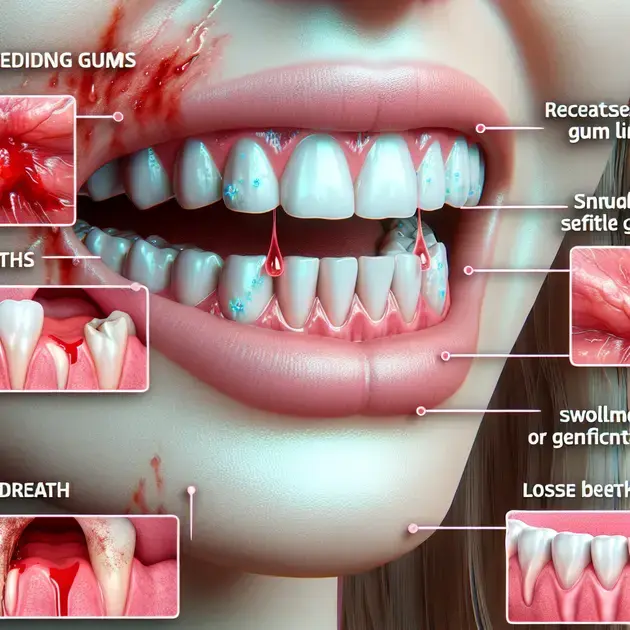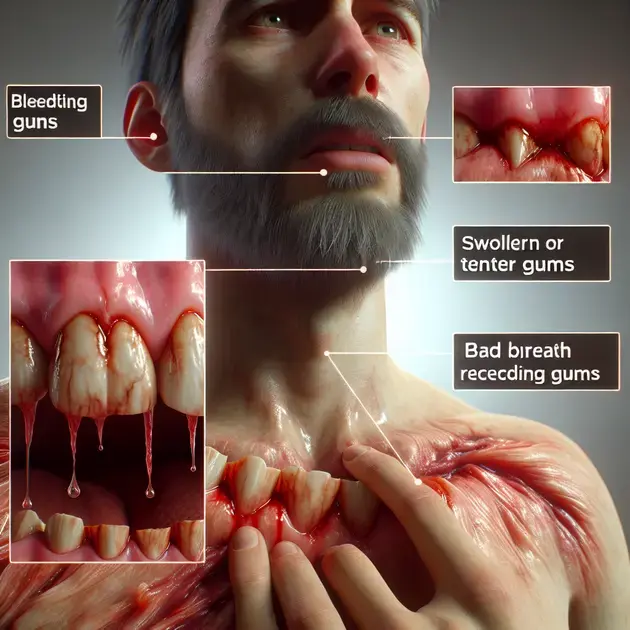Are you experiencing any discomfort or abnormalities in your gums? It’s essential to pay attention to the signs that could indicate you have gum disease. Early detection is crucial in preventing further complications and maintaining good oral health.
According to the American Dental Association, common signs of gum disease include red, swollen, or tender gums, bleeding while brushing or flossing, persistent bad breath, and receding gums. If you notice any of these symptoms, it’s advisable to schedule a dental appointment for a professional evaluation and appropriate treatment.

Early Signs of Gum Disease
Gum disease, also known as periodontal disease, is a common condition that can have serious consequences if left untreated. Recognizing the early signs of gum disease is crucial for timely intervention and prevention of further damage to your oral health. Here are some common early signs to watch out for:
Bleeding Gums
If you notice that your gums bleed when you brush or floss, it could be an early sign of gum disease. Healthy gums should not bleed during routine oral care.
To learn more about the importance of maintaining healthy gums and teeth, you can visit the American Dental Association website at ADA.org.
Swollen or Tender Gums
Swollen or tender gums can also indicate the presence of gum disease. If your gums appear red, swollen, or feel tender to the touch, it is essential to seek dental advice.
To find a trusted dentist in your area for a comprehensive oral evaluation, you can use the Healthgrades app, available for download on both Android and iOS devices.
Bad Breath
Chronic bad breath, also known as halitosis, can be a sign of gum disease. The bacteria that cause gum disease can also contribute to persistent bad breath.
To learn more about the connection between bad breath and gum disease, you can read informative articles on the Colgate website at Colgate.com.
Gum Recession
Receding gums, where the gum tissue pulls back from the teeth, can indicate the progression of gum disease. It is essential to address gum recession promptly to prevent further damage.
To explore treatment options for gum recession, you can consult with a periodontist through the American Academy of Periodontology website at Perio.org.
Importance of Regular Dental Check-ups
Scheduling regular dental check-ups is vital for maintaining optimal oral health and preventing the progression of gum disease. Here are a few reasons why regular dental visits are essential:
Early Detection of Gum Disease
Regular dental check-ups allow your dentist to detect signs of gum disease early on, enabling prompt intervention and treatment.
To schedule a dental check-up with a reputable provider, you can use the Zocdoc app, available for download on both Android and iOS devices.
Professional Cleaning
Professional cleanings during dental check-ups help remove plaque and tartar buildup, reducing the risk of gum disease and cavities.
To find a highly rated dental hygienist for a professional cleaning, you can browse reviews on the Yelp website or app at Yelp.com.
Educational Resources
Dental check-ups provide an opportunity to learn about proper oral hygiene practices and receive personalized advice on maintaining gum health.
To access informative resources on oral health and dental care, you can explore the Mayo Clinic website at MayoClinic.org.
Preventive Care Planning
Regular dental visits allow for the development of a customized preventive care plan to address your specific oral health needs and minimize the risk of gum disease.
To explore preventive care options tailored to your dental health, you can consult with a dental professional at the American Dental Hygienists’ Association website at ADHA.org.
Treatment Options for Gum Disease
When gum disease progresses beyond the early stages, various treatment options are available to address the condition and restore gum health. Here are some common treatment options for gum disease:
Deep Cleaning (Scaling and Root Planing)
Deep cleaning procedures, such as scaling and root planing, are effective in removing plaque and tartar from below the gumline to promote healing and prevent further damage.
To learn more about deep cleaning procedures for gum disease, you can visit the National Institute of Dental and Craniofacial Research website at NIDCR.nih.gov.
Antibiotic Therapy
Antibiotics may be prescribed to treat gum infections and control bacteria growth associated with gum disease. These medications can be administered orally or topically.
To explore antibiotic therapy options for gum disease treatment, you can consult with a healthcare professional through the Centers for Disease Control and Prevention website at CDC.gov.
Surgical Treatment
In advanced cases of gum disease, surgical interventions such as flap surgery or bone grafting may be necessary to restore gum and bone health.
To find a qualified periodontal surgeon for gum disease surgery, you can use the Healthgrades website to search for specialists in your area at Healthgrades.com.
Laser Therapy
Laser therapy is a minimally invasive treatment option for gum disease that can target and eliminate bacteria while promoting tissue regeneration and healing.
To learn more about laser therapy for gum disease, you can read informative articles on the American Academy of Periodontology website at Perio.org.

**
Symptoms that Indicate Gum Disease
**
Introduction
Gum disease, also known as periodontal disease, is a common condition that affects the gums and bone supporting the teeth. Recognizing the early symptoms of gum disease is crucial for timely intervention and preventing further complications. Here are some key symptoms that indicate gum disease:
Bleeding Gums
One of the most common signs of gum disease is bleeding gums, especially during brushing or flossing. Healthy gums should not bleed, so if you notice blood when you clean your teeth, it could be a red flag for gum disease.
It is important to consult your dentist if you experience persistent gum bleeding, as it could indicate inflammation and infection in the gums.
Receding Gums
Gum recession occurs when the gum tissue pulls back from the teeth, exposing the roots. This can be a sign of gum disease, as the supporting structures of the teeth are being affected. Receding gums can also lead to tooth sensitivity and an unattractive smile.
If you notice that your teeth appear longer or that your gums are receding, it is essential to seek dental advice to address the issue before it progresses.
Swollen or Sensitive Gums
Inflammation and tenderness in the gum tissue can indicate gum disease. Swollen or sensitive gums may be accompanied by redness and discomfort, especially when eating or brushing your teeth. Ignoring these symptoms can lead to further oral health problems.
Regular dental check-ups can help identify gum disease in its early stages and prevent complications.
Bad Breath
Chronic bad breath, also known as halitosis, can be a symptom of gum disease. The bacteria that cause gum disease can produce odorous compounds, leading to persistent bad breath that does not improve with oral hygiene practices.
Proper oral hygiene, including regular brushing, flossing, and dental cleanings, can help combat bad breath associated with gum disease.
Tooth Mobility
Loose or shifting teeth can indicate advanced gum disease that has affected the bone supporting the teeth. As the condition progresses, the teeth may become mobile and even fall out if left untreated.
Early detection and treatment of gum disease are essential to prevent tooth loss and maintain a healthy smile.
**
Conclusion
**
In conclusion, gum disease, or periodontal disease, is a prevalent oral condition that can have serious implications if left untreated. By being aware of the early symptoms mentioned in this article, individuals can take proactive steps to address gum disease before it progresses into more severe stages.
Bleeding Gums
Noticing bleeding gums, particularly during routine oral care, should prompt individuals to seek professional dental advice. Persistent gum bleeding may signal an underlying issue of inflammation and infection that requires attention to prevent further damage.
Receding Gums
The appearance of receding gums indicates potential gum disease, affecting the stability of teeth and leading to sensitivity concerns. Seeking timely dental intervention when gums start receding can help prevent complications and maintain oral health.
Swollen or Sensitive Gums
Swollen or sensitive gums, accompanied by redness and discomfort, can be early signs of gum disease. Regular dental check-ups play a crucial role in identifying these symptoms early on, allowing for timely treatment and preventing the progression of the condition.
Bad Breath
Chronic bad breath, also linked to gum disease, should not be overlooked. Proper oral hygiene practices, including brushing, flossing, and professional cleanings, are essential in combating the odorous compounds produced by bacteria that contribute to bad breath.
Tooth Mobility
Notably, tooth mobility signifies advanced gum disease that has affected the bone supporting the teeth. Early detection, through regular dental visits and awareness of symptoms, is key to preventing tooth loss and sustaining a healthy, functional smile.
Overall, recognizing these symptoms early and seeking professional dental care can make a significant difference in effectively managing gum disease and preserving long-term oral health.
